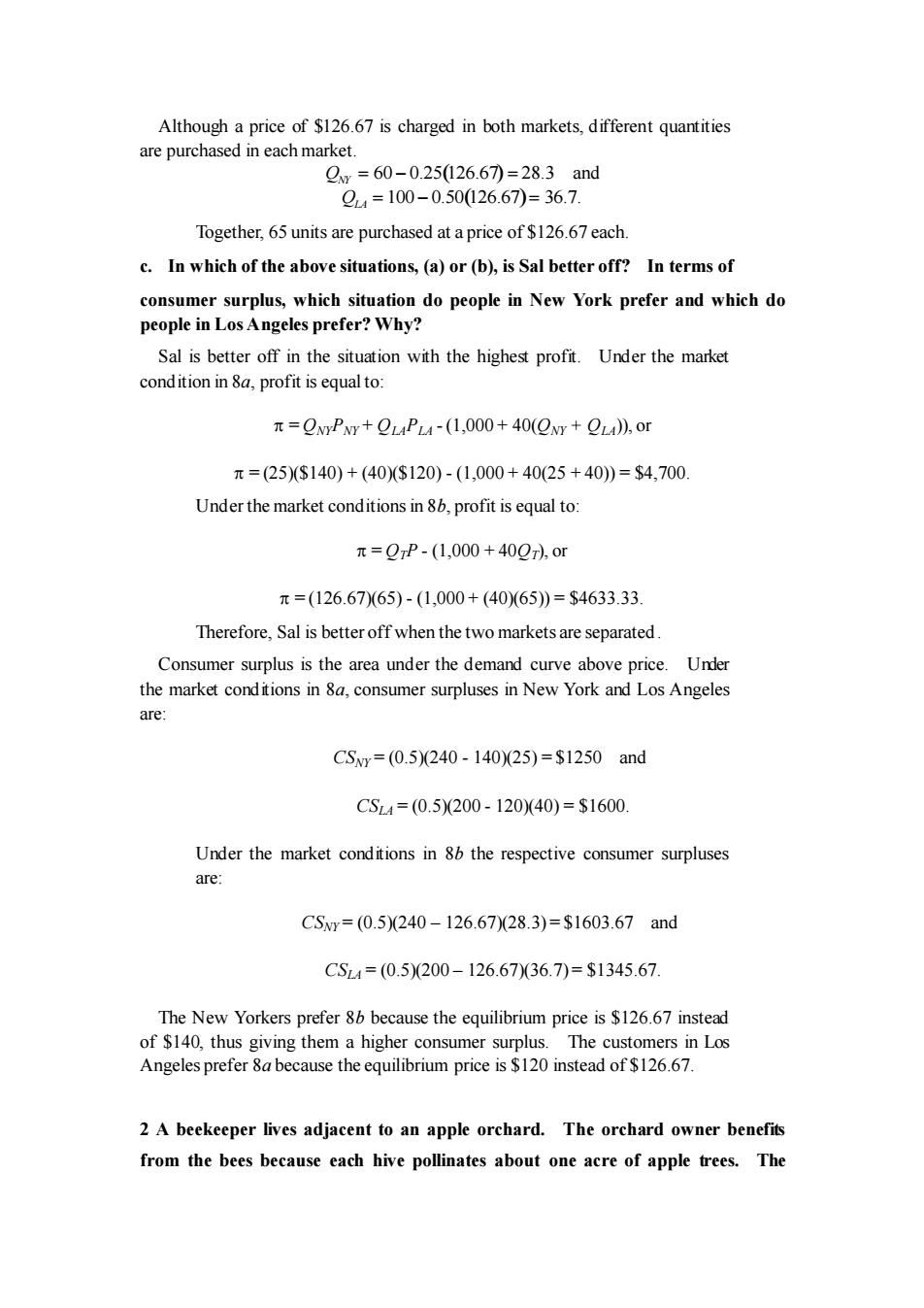正在加载图片...

Although a price of$126.67 is charged in both markets,different quantities are purchased in each market. Qw=60-0.25026.6)=28.3 and 91=100-0.50126.67=36.7. Together,65 units are purchased at a price of $126.67 each. c.In which of the above situations,(a)or(b),is Sal better off?In terms of consumer surplus,which situation do people in New York prefer and which do people in Los Angeles prefer?Why? Sal is better off in the situation with the highest profit.Under the market condition inprofit is equal to π=P+OLP-(1,000+40(w+Q八.om 元=(25($140)+(40(120)-(1,000+40(25+40)=$4,700 Under the market conditions in profit is equal to π=0P-(1,000+402,or π=(126.67)(65)-(1,000+(40)(65)》=$4633.33. Therefore,Sal is better off when the two markets are separated Consumer surplus is the area under the demand curve above price.Under the market conditions in 8a,consumer surpluses in New York and Los Angeles are: CSw=(0.5X240-14025)=$1250and CS4=(0.5)200-12040)=$1600 Under the market conditions in 8b the respective consumer surpluses are: CSr=(0.5240-126.67)28.3)=$1603.67and CS4=(0.5200-126.6736.7)=$1345.67 The New Yorkers prefer 8b because the equilibrium price is $126.67 instead of $140,thus giving them a higher consumer surplus.The customers in Los Angeles prefer 8a because the equilibrium price is $120 instead of $126.67. 2 A beekeeper lives adjacent to an apple orchard.The orchard owner benefits from the bees because each hive pollinates about one acre of apple trees.TheAlthough a price of $126.67 is charged in both markets, different quantities are purchased in each market. QNY = 60 − 0.25(126.67) = 28.3 and QLA = 100− 0.50(126.67)= 36.7. Together, 65 units are purchased at a price of $126.67 each. c. In which of the above situations, (a) or (b), is Sal better off? In terms of consumer surplus, which situation do people in New York prefer and which do people in Los Angeles prefer? Why? Sal is better off in the situation with the highest profit. Under the market condition in 8a, profit is equal to: = QNYPNY + QLAPLA - (1,000 + 40(QNY + QLA)), or = (25)($140) + (40)($120) - (1,000 + 40(25 + 40)) = $4,700. Under the market conditions in 8b, profit is equal to: = QTP - (1,000 + 40QT), or = (126.67)(65) - (1,000 + (40)(65)) = $4633.33. Therefore, Sal is better off when the two markets are separated. Consumer surplus is the area under the demand curve above price. Under the market conditions in 8a, consumer surpluses in New York and Los Angeles are: CSNY = (0.5)(240 - 140)(25) = $1250 and CSLA = (0.5)(200 - 120)(40) = $1600. Under the market conditions in 8b the respective consumer surpluses are: CSNY = (0.5)(240 – 126.67)(28.3) = $1603.67 and CSLA = (0.5)(200 – 126.67)(36.7) = $1345.67. The New Yorkers prefer 8b because the equilibrium price is $126.67 instead of $140, thus giving them a higher consumer surplus. The customers in Los Angeles prefer 8a because the equilibrium price is $120 instead of $126.67. 2 A beekeeper lives adjacent to an apple orchard. The orchard owner benefits from the bees because each hive pollinates about one acre of apple trees. The